Abstract
Many occupational and environmental health hazards present as an increased reporting of non-specific symptoms such as headache, backache, eye and respiratory irritation, tiredness, memory problems, and poor concentration. The pattern and number of such symptoms is surprisingly constant from hazard to hazard suggesting that common psychological and social factors, not directly related to the exposure may be involved. A recent workshop (see acknowledgements) was held to review the pattern of symptoms in varying hazardous situations and the psychological mechanisms behind the genesis and maintenance of symptoms. The involvement of both direct physicochemical and psychological mechanisms in symptom generation and reporting in any situation was discussed and is reported here. A model that identifies the issues that need to be considered in any epidemiological study based on the incidence or prevalence of non-specific symptoms is proposed.
Full text
PDF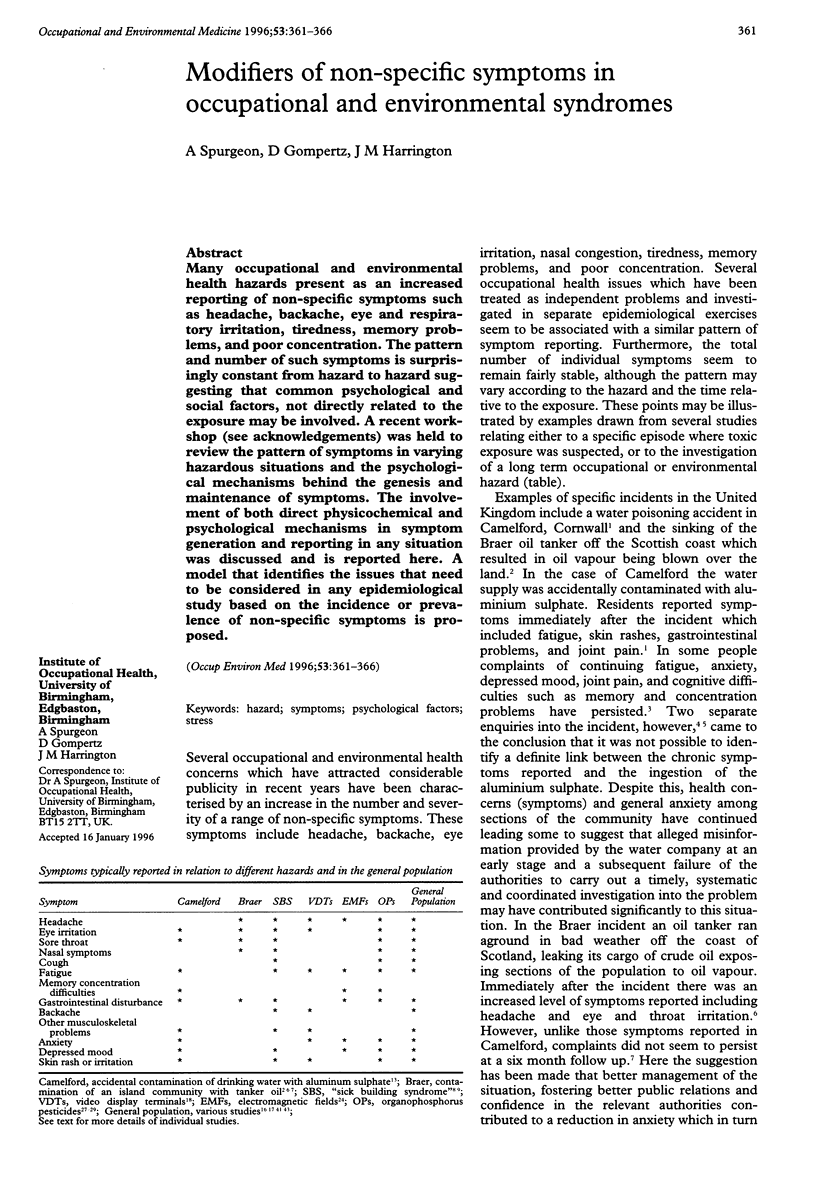
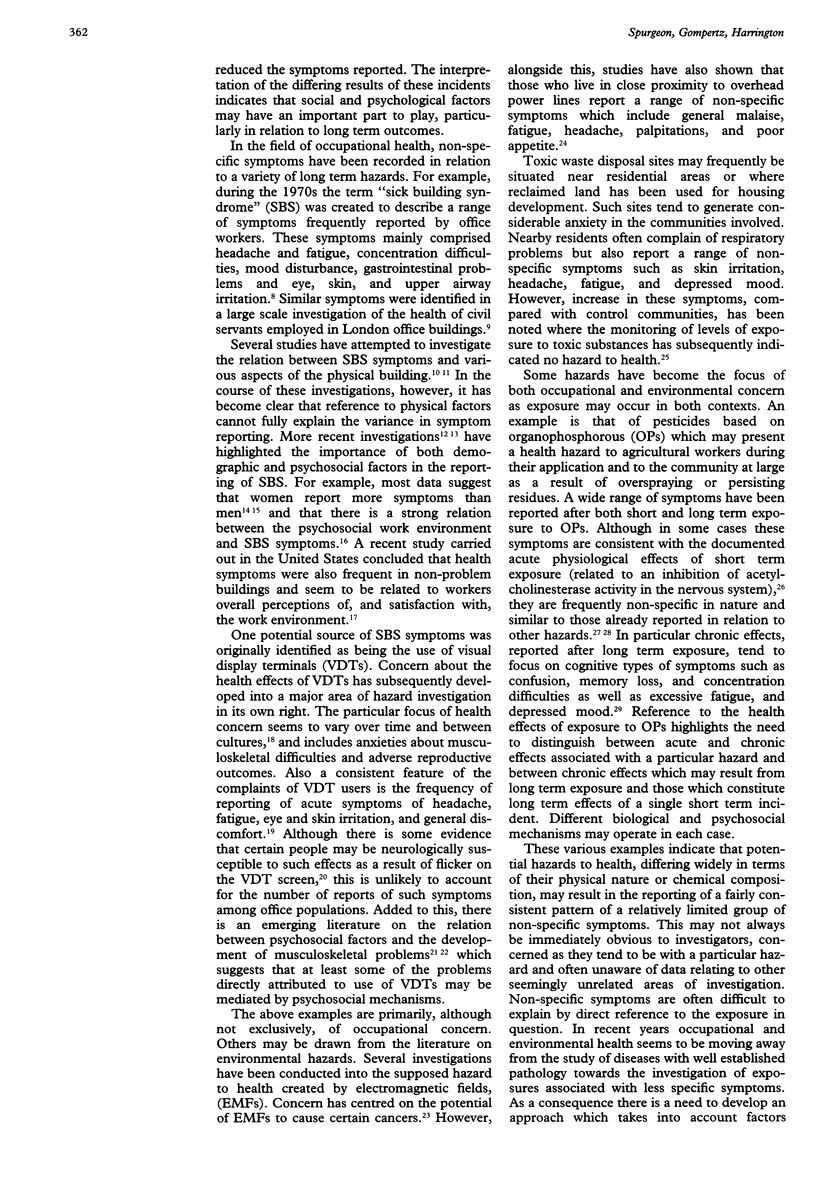
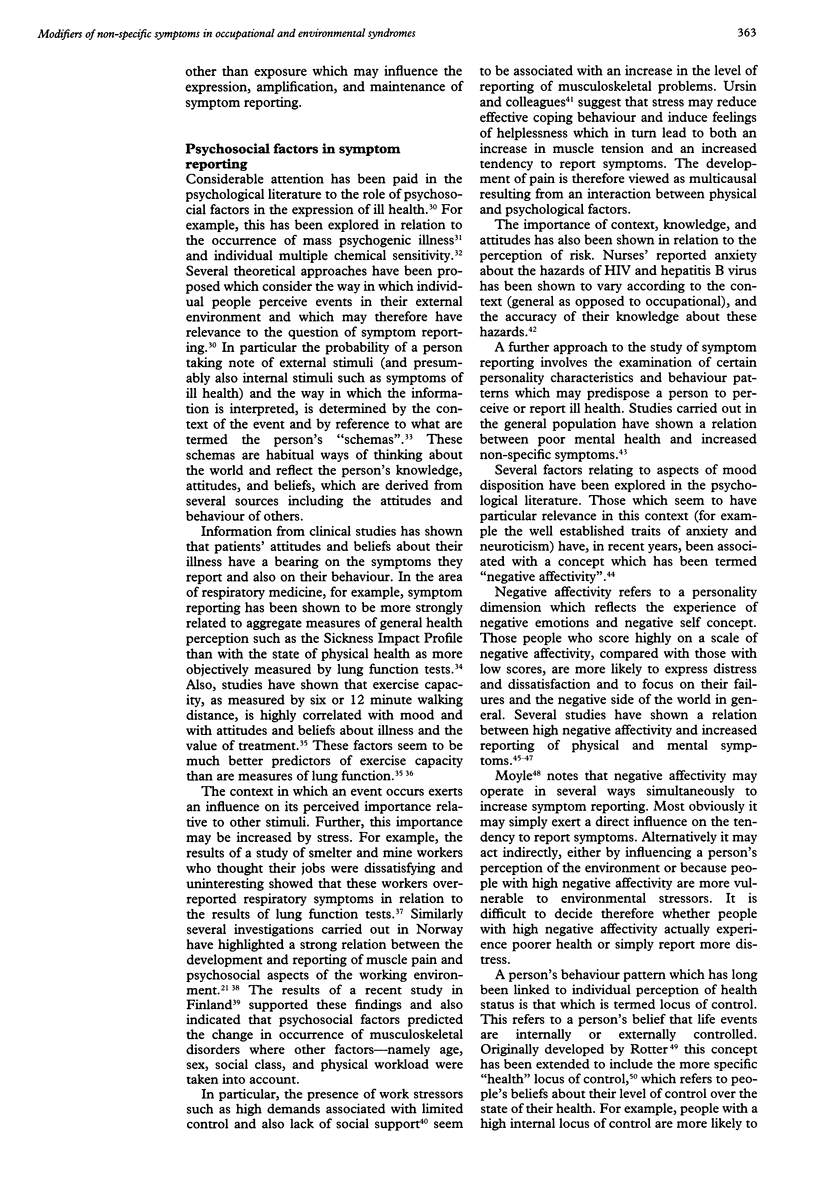
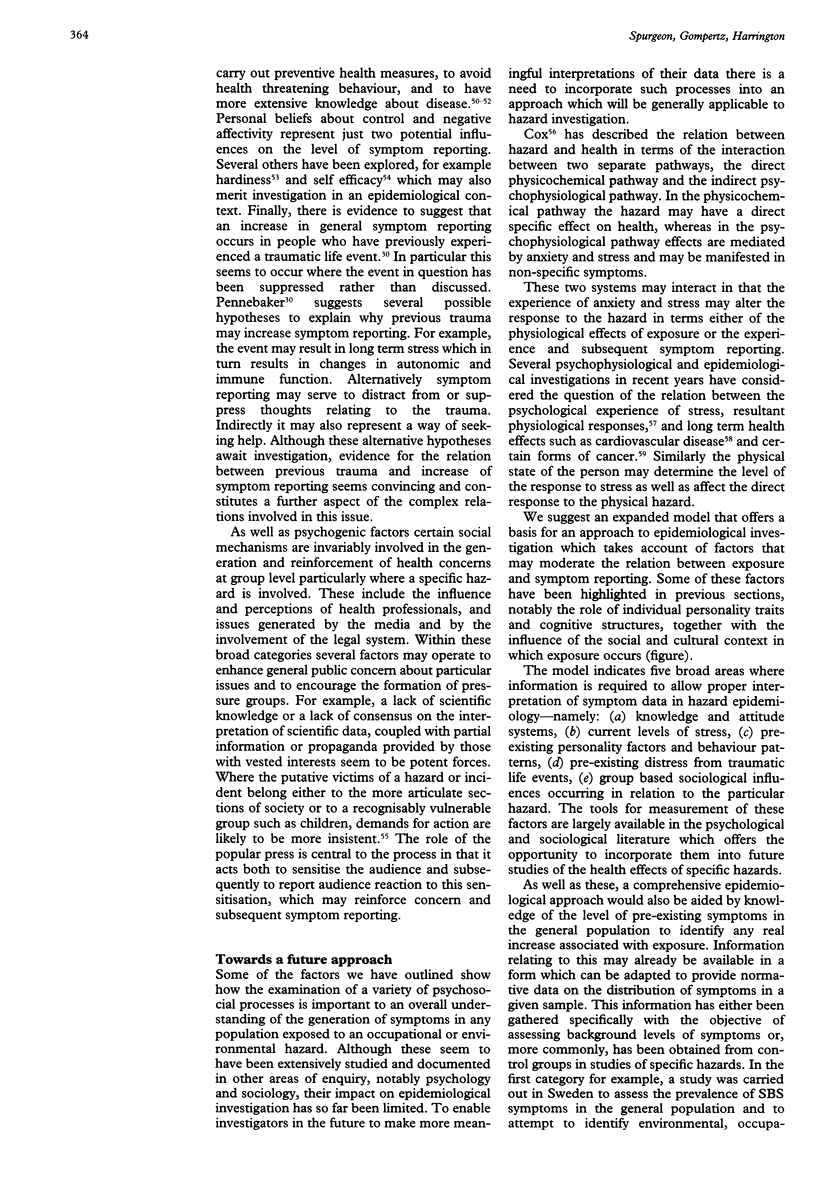
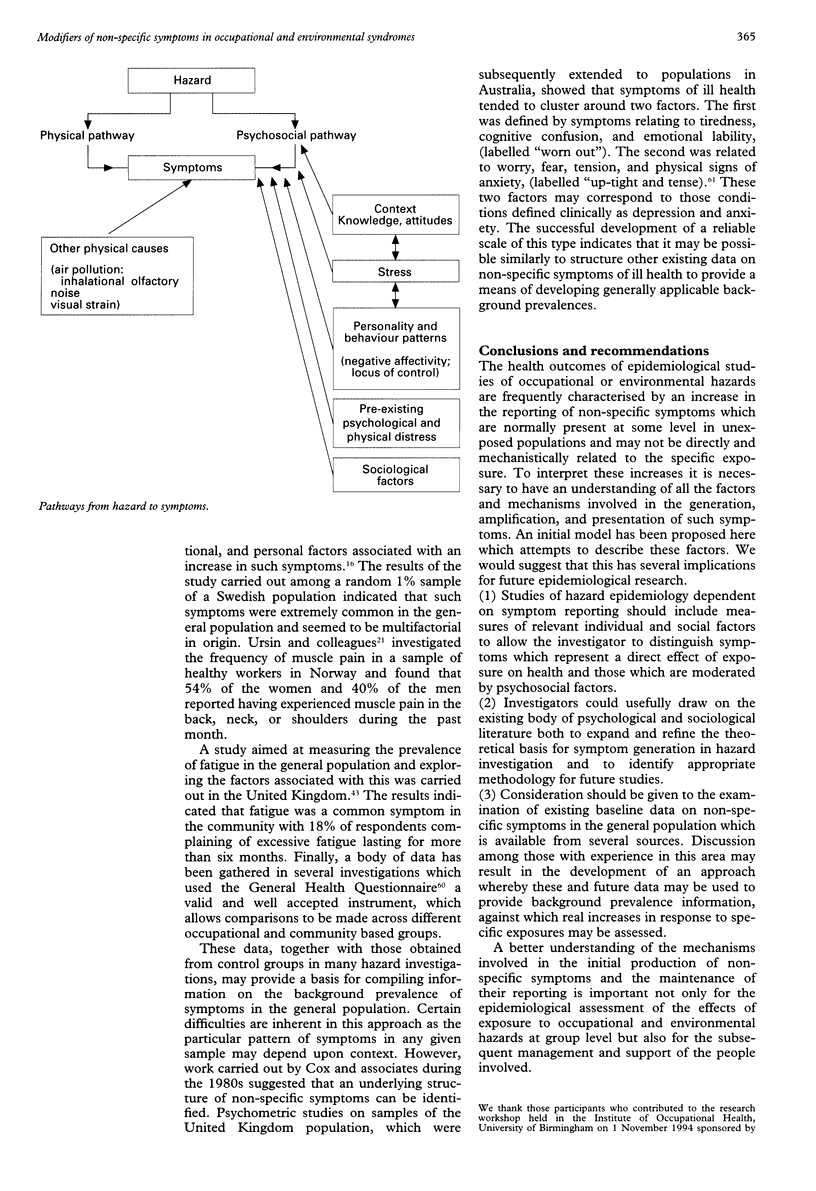
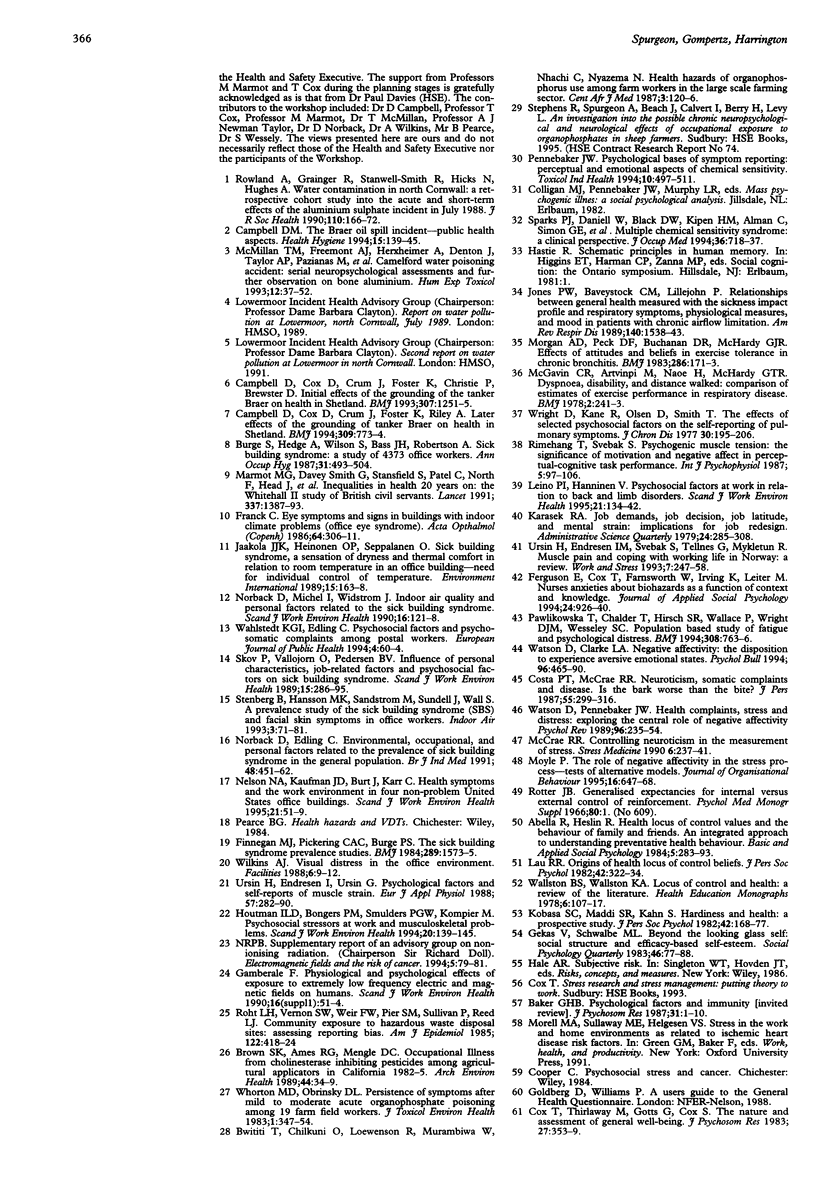
Selected References
These references are in PubMed. This may not be the complete list of references from this article.
- Baker G. H. Psychological factors and immunity. J Psychosom Res. 1987;31(1):1–10. doi: 10.1016/0022-3999(87)90092-4. [DOI] [PubMed] [Google Scholar]
- Brown S. K., Ames R. G., Mengle D. C. Occupational illnesses from cholinesterase-inhibiting pesticides among agricultural applicators in California, 1982-1985. Arch Environ Health. 1989 Jan-Feb;44(1):34–39. doi: 10.1080/00039896.1989.9935870. [DOI] [PubMed] [Google Scholar]
- Burge S., Hedge A., Wilson S., Bass J. H., Robertson A. Sick building syndrome: a study of 4373 office workers. Ann Occup Hyg. 1987;31(4A):493–504. doi: 10.1093/annhyg/31.4a.493. [DOI] [PubMed] [Google Scholar]
- Bwititi T., Chikuni O., Loewenson R., Murambiwa W., Nhachi C., Nyazema N. Health hazards in organophosphate use among farm workers in the large-scale farming sector. Cent Afr J Med. 1987 May;33(5):120–126. [PubMed] [Google Scholar]
- Campbell D., Cox D., Crum J., Foster K., Christie P., Brewster D. Initial effects of the grounding of the tanker Braer on health in Shetland. The Shetland Health Study Group. BMJ. 1993 Nov 13;307(6914):1251–1255. doi: 10.1136/bmj.307.6914.1251. [DOI] [PMC free article] [PubMed] [Google Scholar]
- Campbell D., Cox D., Crum J., Foster K., Riley A. Later effects of grounding of tanker Braer on health in Shetland. BMJ. 1994 Sep 24;309(6957):773–774. doi: 10.1136/bmj.309.6957.773. [DOI] [PMC free article] [PubMed] [Google Scholar]
- Costa P. T., Jr, McCrae R. R. Neuroticism, somatic complaints, and disease: is the bark worse than the bite? J Pers. 1987 Jun;55(2):299–316. doi: 10.1111/j.1467-6494.1987.tb00438.x. [DOI] [PubMed] [Google Scholar]
- Cox T., Thirlaway M., Gotts G., Cox S. The nature and assessment of general well-being. J Psychosom Res. 1983;27(5):353–359. doi: 10.1016/0022-3999(83)90066-1. [DOI] [PubMed] [Google Scholar]
- Finnegan M. J., Pickering C. A., Burge P. S. The sick building syndrome: prevalence studies. Br Med J (Clin Res Ed) 1984 Dec 8;289(6458):1573–1575. doi: 10.1136/bmj.289.6458.1573. [DOI] [PMC free article] [PubMed] [Google Scholar]
- Franck C. Eye symptoms and signs in buildings with indoor climate problems ('office eye syndrome'). Acta Ophthalmol (Copenh) 1986 Jun;64(3):306–311. doi: 10.1111/j.1755-3768.1986.tb06925.x. [DOI] [PubMed] [Google Scholar]
- Gamberale F. Physiological and psychological effects of exposure to extremely low-frequency electric and magnetic fields on humans. Scand J Work Environ Health. 1990;16 (Suppl 1):51–54. doi: 10.5271/sjweh.1821. [DOI] [PubMed] [Google Scholar]
- Gecas V., Schwalbe M. L. Beyond the looking-glass self: social structure and efficacy-based self-esteem. Soc Psychol Q. 1983 Jun;46(2):77–88. [PubMed] [Google Scholar]
- Houtman I. L., Bongers P. M., Smulders P. G., Kompier M. A. Psychosocial stressors at work and musculoskeletal problems. Scand J Work Environ Health. 1994 Apr;20(2):139–145. doi: 10.5271/sjweh.1419. [DOI] [PubMed] [Google Scholar]
- Jones P. W., Baveystock C. M., Littlejohns P. Relationships between general health measured with the sickness impact profile and respiratory symptoms, physiological measures, and mood in patients with chronic airflow limitation. Am Rev Respir Dis. 1989 Dec;140(6):1538–1543. doi: 10.1164/ajrccm/140.6.1538. [DOI] [PubMed] [Google Scholar]
- Kobasa S. C., Maddi S. R., Kahn S. Hardiness and health: a prospective study. J Pers Soc Psychol. 1982 Jan;42(1):168–177. doi: 10.1037//0022-3514.42.1.168. [DOI] [PubMed] [Google Scholar]
- Lau R. R. Origins of health locus of control beliefs. J Pers Soc Psychol. 1982 Feb;42(2):322–334. doi: 10.1037//0022-3514.42.2.322. [DOI] [PubMed] [Google Scholar]
- Leino P. I., Hänninen V. Psychosocial factors at work in relation to back and limb disorders. Scand J Work Environ Health. 1995 Apr;21(2):134–142. doi: 10.5271/sjweh.20. [DOI] [PubMed] [Google Scholar]
- Marmot M. G., Smith G. D., Stansfeld S., Patel C., North F., Head J., White I., Brunner E., Feeney A. Health inequalities among British civil servants: the Whitehall II study. Lancet. 1991 Jun 8;337(8754):1387–1393. doi: 10.1016/0140-6736(91)93068-k. [DOI] [PubMed] [Google Scholar]
- McGavin C. R., Artvinli M., Naoe H., McHardy G. J. Dyspnoea, disability, and distance walked: comparison of estimates of exercise performance in respiratory disease. Br Med J. 1978 Jul 22;2(6132):241–243. doi: 10.1136/bmj.2.6132.241. [DOI] [PMC free article] [PubMed] [Google Scholar]
- McMillan T. M., Freemont A. J., Herxheimer A., Denton J., Taylor A. P., Pazianas M., Cummin A. R., Eastwood J. B. Camelford water poisoning accident: serial neuropsychological assessments and further observations on bone aluminium. Hum Exp Toxicol. 1993 Jan;12(1):37–42. doi: 10.1177/096032719301200108. [DOI] [PubMed] [Google Scholar]
- Morgan A. D., Peck D. F., Buchanan D. R., McHardy G. J. Effect of attitudes and beliefs on exercise tolerance in chronic bronchitis. Br Med J (Clin Res Ed) 1983 Jan 15;286(6360):171–173. doi: 10.1136/bmj.286.6360.171. [DOI] [PMC free article] [PubMed] [Google Scholar]
- Nelson N. A., Kaufman J. D., Burt J., Karr C. Health symptoms and the work environment in four nonproblem United States office buildings. Scand J Work Environ Health. 1995 Feb;21(1):51–59. doi: 10.5271/sjweh.8. [DOI] [PubMed] [Google Scholar]
- Norbäck D., Edling C. Environmental, occupational, and personal factors related to the prevalence of sick building syndrome in the general population. Br J Ind Med. 1991 Jul;48(7):451–462. doi: 10.1136/oem.48.7.451. [DOI] [PMC free article] [PubMed] [Google Scholar]
- Norbäck D., Michel I., Widström J. Indoor air quality and personal factors related to the sick building syndrome. Scand J Work Environ Health. 1990 Apr;16(2):121–128. doi: 10.5271/sjweh.1808. [DOI] [PubMed] [Google Scholar]
- Pawlikowska T., Chalder T., Hirsch S. R., Wallace P., Wright D. J., Wessely S. C. Population based study of fatigue and psychological distress. BMJ. 1994 Mar 19;308(6931):763–766. doi: 10.1136/bmj.308.6931.763. [DOI] [PMC free article] [PubMed] [Google Scholar]
- Pennebaker J. W. Psychological bases of symptom reporting: perceptual and emotional aspects of chemical sensitivity. Toxicol Ind Health. 1994 Jul-Oct;10(4-5):497–511. [PubMed] [Google Scholar]
- Rimehaug T., Svebak S. Psychogenic muscle tension: the significance of motivation and negative affect in perceptual-cognitive task performance. Int J Psychophysiol. 1987 Jul;5(2):97–106. doi: 10.1016/0167-8760(87)90014-6. [DOI] [PubMed] [Google Scholar]
- Roht L. H., Vernon S. W., Weir F. W., Pier S. M., Sullivan P., Reed L. J. Community exposure to hazardous waste disposal sites: assessing reporting bias. Am J Epidemiol. 1985 Sep;122(3):418–433. doi: 10.1093/oxfordjournals.aje.a114123. [DOI] [PubMed] [Google Scholar]
- Rotter J. B. Generalized expectancies for internal versus external control of reinforcement. Psychol Monogr. 1966;80(1):1–28. [PubMed] [Google Scholar]
- Rowland A., Grainger R., Smith R. S., Hicks N., Hughes A. Water contamination in North Cornwall: a retrospective cohort study into the acute and short-term effects of the aluminum sulphate incident in July 1988. J R Soc Health. 1990 Oct;110(5):166–172. doi: 10.1177/146642409011000507. [DOI] [PubMed] [Google Scholar]
- Skov P., Valbjørn O., Pedersen B. V. Influence of personal characteristics, job-related factors and psychosocial factors on the sick building syndrome. Danish Indoor Climate Study Group. Scand J Work Environ Health. 1989 Aug;15(4):286–295. doi: 10.5271/sjweh.1851. [DOI] [PubMed] [Google Scholar]
- Sparks P. J., Daniell W., Black D. W., Kipen H. M., Altman L. C., Simon G. E., Terr A. I. Multiple chemical sensitivity syndrome: a clinical perspective. I. Case definition, theories of pathogenesis, and research needs. J Occup Med. 1994 Jul;36(7):718–730. [PubMed] [Google Scholar]
- Ursin H., Endresen I. M., Ursin G. Psychological factors and self-reports of muscle pain. Eur J Appl Physiol Occup Physiol. 1988;57(3):282–290. doi: 10.1007/BF00635986. [DOI] [PubMed] [Google Scholar]
- Wallston B. D., Wallston K. A. Locus of control and health: a review of the literature. Health Educ Monogr. 1978 Spring;6(2):107–117. doi: 10.1177/109019817800600102. [DOI] [PubMed] [Google Scholar]
- Watson D., Clark L. A. Negative affectivity: the disposition to experience aversive emotional states. Psychol Bull. 1984 Nov;96(3):465–490. [PubMed] [Google Scholar]
- Whorton M. D., Obrinsky D. L. Persistence of symptoms after mild to moderate acute organophosphate poisoning among 19 farm field workers. J Toxicol Environ Health. 1983 Mar;11(3):347–354. doi: 10.1080/15287398309530348. [DOI] [PubMed] [Google Scholar]
- Wright D. D., Kane R. L., Olsen D. M., Smith T. J. The effects of selected psychosocial factors on the self-reporting of pulmonary symptoms. J Chronic Dis. 1977 Apr;30(4):195–206. doi: 10.1016/0021-9681(77)90040-6. [DOI] [PubMed] [Google Scholar]


